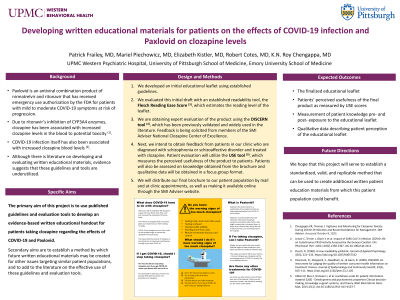COVID-19
Session: Poster Session
(064) Developing Written Educational Materials for Patients on the Effects of COVID-19 Infection and Paxlovid Use on Clozapine Levels

Trainee Involvement: Yes

Patrick Frailey, MD
resident physician
UPMC Western Psychiatric Hospital
Pittsburgh, Pennsylvania, United States
Mariel Piechowicz, MD
Resident Physician
University of Pittsburgh Medical Center
Pittsburgh, Pennsylvania, United States- EK
Elizabeth Kistler, MD
Assistant Professor of Psychiatry
University of Pittsburgh Medical Center
Pittsburgh, Pennsylvania, United States - KC
K.N. Roy Chengappa, MD
Professor of Psychiatry
Western Psychiatric Hospital - UPMC
Pittsburgh, Pennsylvania, United States
Presenting Author(s)
Co-Author(s)
Background: The consult-liaison psychiatrist is tasked with managing psychiatric medications in the setting of medical comorbidity. With the rise of the COVID-19 pandemic and the FDA’s approval of the antiviral combination product Paxlovid for emergency use, we identified a need for patient education on the potential of COVID-19 infection and its treatment with Paxlovid to cause clozapine toxicity (Lenoir et al., 2021, Chengappa and Thomas, 2022). We hypothesize that through an iterative process using evidence-based guidelines and validated tools, we can create a patient educational leaflet of high utility.
Methods: After a literature review on developing written patient educational materials, we created a draft of our leaflet on clozapine use, COVID-19 infection, and Paxlovid. Our next step is revision using the Flesch Reading Ease Scale (Flesch, 1948) to achieve an appropriate reading level. Next, we will obtain expert feedback using the DISCERN instrument (Charnock et al., 1999). Finally, with the approval of our Institutional Review Board, we will elicit feedback on initial and final drafts from two focus groups of 6-8 patients with diagnoses of schizophrenia or schizoaffective disorder who are prescribed clozapine using the USE instrument, designed for patients to rate the subjective usefulness of written educational materials (Hölzel et al., 2015).
Results: Our primary outcome will be USE scores of the final draft as compared to the initial draft to assess how our interventions correlated with patients’ perceived usefulness. We expect that our data will show an increase in perceived utility of the educational material after assessment of readability and expert evaluation. Our final version will be distributed to patients within our clinic and hospital system and will also be offered for online distribution via the SMI Adviser website.
Discussion: This project builds on the literature regarding evidence-based guidelines and validated tools for the development of patient educational materials. We expect our results will demonstrate a direct translation into patient’s perceived usefulness.
Conclusion: We hope that this project will demonstrate a pathway to develop useful patient educational materials, while simultaneously addressing an identified need in this specific patient population.
References:
1. Charnock D, Shepperd S, Needham G, Gann R. DISCERN: An instrument for judging the quality of written consumer health information on treatment choices. Journal of Epidemiology and Community Health. 1999;53(2):105–111. https://doi.org/10.1136/jech.53.2.105
2. Chengappa KNR, Thomas J. Vigilance and Monitoring for Clozapine Toxicity During COVID-19 Infection and Recommendations for Management - SMI Adviser. 2002. Accessed 4/2/2023.
3. Flesch, R. A new readability yardstick. Journal of Applied Psychology 1948: 32(3);221–233. https://doi.org/10.1037/h0057532
4. Hölzel LP, Ries Z, Dirmaier J, Zill JM, Kriston L, Klesse C, Härter M, Bermejo I. Usefulness scale for patient information material (USE): Development and psychometric properties. BMC Medical Informatics and Decision Making. 2015:15(1). https://doi.org/10.1186/s12911-015-0153-7
5. Lenoir C., Terrier J., Gloor Y., Curtin F, Rollason, V, Desmeules, JA, Daali, Y, Reny, JL, Samer CF). Impact of SARS-CoV-2 Infection (COVID-19) on Cytochromes P450 Activity Assessed by the Geneva Cocktail. Clinical Pharmacology and Therapeutics. 2021:110(5);1358–1367. https://doi.org/10.1002/cpt.2412

